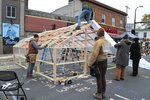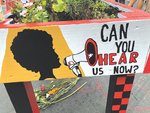







At the center of the intersection at 38th St. and Chicago Ave. S., a large sculpture of a fist holding a red, black and green striped Pan-African flag is surrounded by a circular garden. On Chicago Ave. facing north, candles, flowers and tributes are laid around a figure painted on the street, face down, with angel’s wings – the place where George Floyd took his last breath. Next to this a giant portrait of George Floyd stands tall against the bus shelter.
In the months since Minneapolis police took George Floyd’s life on May 25, people from all over the world have visited the memorial to pay their respects, often placing tributes large and small on the surrounding sidewalks and streets. Tiny figurines, stuffed animals, votives, cut flowers and plantings rest alongside children’s drawings, handwritten letters, protest placards, street art, murals and sculptures.
“It’s a living memorial,” said Jeanelle Austin, who as lead caretaker sees every single thing that is left there. Asked what it’s like to witness new arrivals in this ever-changing space, she said “It’s beautiful. Because it says that people are finding a way to express themselves.”
Answering a call
In the midst of the uprising, Austin’s mother called her back home to the neighborhood where she grew up, a couple of blocks from 38th and Chicago, asking her to help - “because this is what you do.” Austin flew in from Texas on May 29, witnessed the National Guard driving through the middle of the memorial the next day, and experienced the tanker driving through the protest on I-35W on May 31.
“That was the most traumatizing day of protesting ever, and I woke up the next morning… and I said ‘You know what? I know how to tend to a memorial,” said Austin. Having done so for a memorial for Black lives in Pasadena, Calif., Austin knows that it not only helps the movement, it is work that helps her heal. So on June 1, she began picking up trash and tidying up the site and has been dedicated to caring for the space since.
“My obligation is to pursue justice. That’s my life’s call,” she said. “And so I kept tending to the memorial, because I saw no reason to stop.”
Usually Austin discovers along with everyone else what’s been placed at the memorial, even the larger installations like the fist, which just showed up in the middle of the street one day.
“That’s part of the beauty of it being a living memorial… I get up at 6 a.m., I come when there’s no one there, I’m like, ‘Oh, that came today.” She laughed, then pointed out that it isn’t her job to patrol what can and can’t be left there. Rather, it’s to tend to whatever is left there. “If you leave it, know that it’s gonna get taken care of.”
Expressions of pain and hope
What some people consider art, Austin calls “creative expressions of pain and hope.” The memorial is a place where people can be honest and real with the pain as well as the joy that they feel and experience, a place where kids and adults can be free.
She described an interaction with one mother, who had been looking all over for her son and eventually found him playing with Austin’s nieces and nephews. The woman told her he doesn’t usually play with other kids. They had tried therapy, coaching and social integration.
“She was like… ‘Oh my gosh, this space has freed him to play in a way he has never felt free to do before,’” said Austin. “And so even in the midst of all the trauma, this place has organically provided a healing that I think is undeniable.”
In October, a vehicle approached the south gate. A middle aged Black man was with his elderly mother, who lives a block away and wanted to see the memorial. It was her first time out during the pandemic, and she was unable to walk. So Austin walked in front of the car as the man drove into the space and pulled up right next to the fist. He pointed it out, asking his mother if she could see it. Likewise, the canopy covering the site where George Floyd died. She squinted, looking, and then asked, “Is that it? Is that black thing the tent?” When her son replied yes, she said, “Okay. Okay. We can go now. Thank you.”
This moved Austin to tears.
“To know that my elder had the opportunity to see the pulse of an international movement, the heartbeat of it, where it started… because she knows more than I do, the pain of lynching. She knows more than I do the struggle for Black liberation. She knows more than I do what it means to be Black in America, what it means to be a Black woman in America,” she said. “So the privilege for me to be able to guide her to the moment, through her aged eyes to see what she could barely see, and feel satisfied, yes, she can go home now… This is how much it matters.”
Tending to the tributes
There are two guiding principles for tending to the memorial. First, everything is someone’s offering; nothing gets thrown away. Second, people are more sacred than the memorial itself.
Austin believes caretakers have a responsibility to tend to the space so people can experience it without distraction – not doing the work during the middle of the day or high peak hours. Their role, Austin described, is “to allow people just to feel that everything is as it needs to be for them in that moment and how they feel like they need to pay their respects.” She mentioned seeing a gentleman who was walking his bike stop and pour water from his water bottle into a planter to water it, offer a blessing, and keep moving.
“Everyone is giving in their own way. And it’s absolutely phenomenal,” she said.
The routine for tending to the memorial is largely determined by the weather – rain, snow, high wind – but generally it is “show up, see who else shows up, assess the space, what needs to be done, do it.” Volunteers take a section of the memorial, sweeping and picking up trash as needed. Flowers in plastic are unwrapped and returned to their place. Signs that have been blown off are reinforced or placed in a designated area to be taken to conservation.
“It’s recognizing that the piece is too fragile to actually go without the piece being attended to,” said Austin.
Pillsbury House Theatre has lent space for the memorial (though with more than 2,500 items, it is filling up quickly), and Midwest Art Conservation Center volunteers provide guidance for items brought indoors for conservation. This work is done assembly-line style, the biggest bulk of items being protest signs.
Volunteers first assess the status of the piece, whether it is wet, moldy, damaged or dirty. They then section it off for where it needs to go – onto blot paper for drying or to “damaged,” “mold,” “dirty” or “clean.” Dirty gets clean (though not always, they recognize cleaning is irreversible), damaged gets reassessed for how to get reassembled in a way that doesn’t take away from its story.
There’s also a station for complex items, such as a piece where a candle melted onto a different offering, where multiple stages of care may be taken. Items that were burned in a fire will reside in yet a different category, “burnt offerings.”
A Global Memorial
About two months into caretaking, Austin reached out to George Floyd’s family to ask how they wanted to move forward. This led to the formation of the George Floyd Global Memorial, a nonprofit organization that governs the pieces for the public. At its official launch on Oct. 14, George “Perry” Floyd’s birthday, George Floyd’s aunt, Angela Harrelson, and cousin, Paris Stevens, co-chairs for the organization, shared these words:
“We would like to thank the community for the love and support you’ve shown Perry (George Floyd). It is clear that you are not only a community but family. The outpour of offerings that people leave at the memorial represent their condolences in the ongoing pursuit for justice. The offerings are genuine expressions of compassion, loyalty, and their commitment, which is priceless.”
The memorial just began a “one million donors campaign,” in which they’re asking those interested to give one dollar (or more) to support and be a part of the memorial. Details are on their website at www.georgefloydglobalmemorial.org and on Facebook.
Comments
No comments on this item Please log in to comment by clicking here